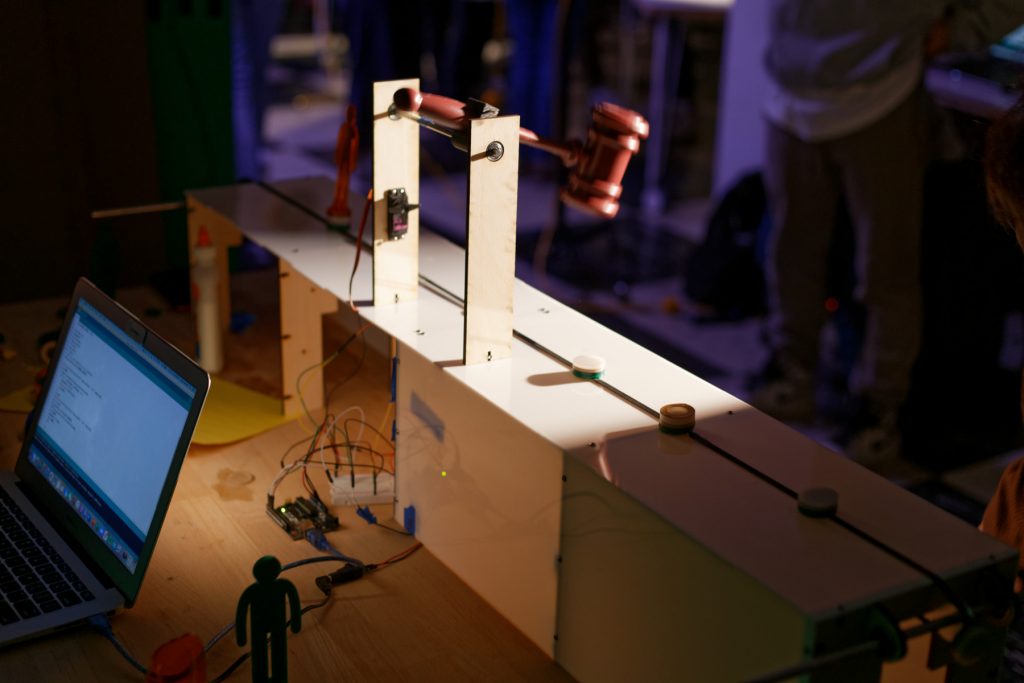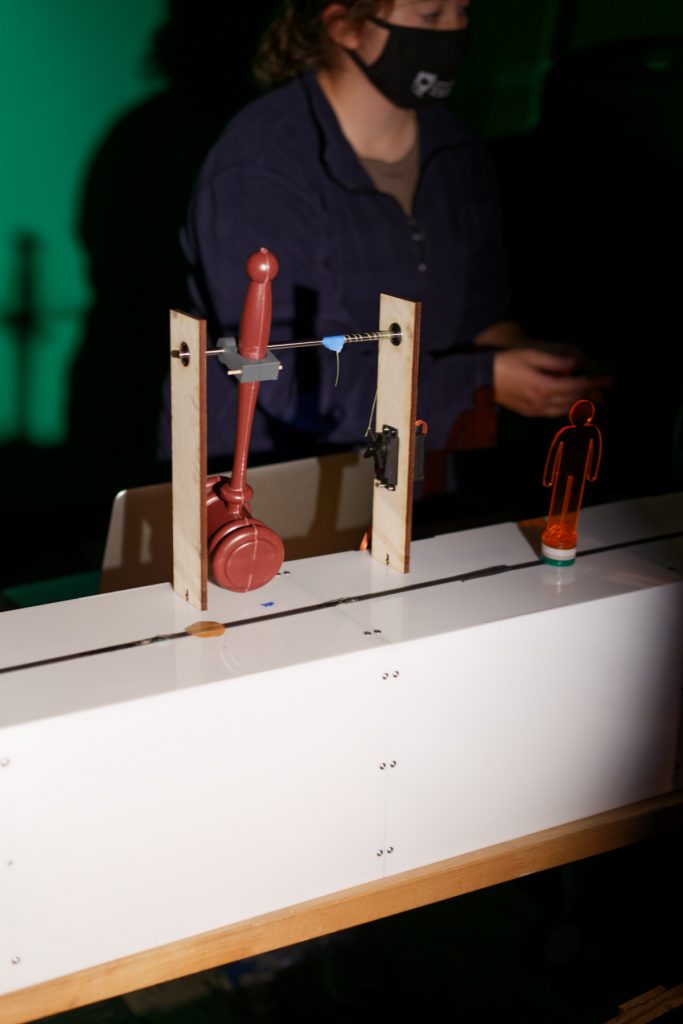By Mimi and Anjali

Project Narrative
The concept
‘Where Did Alam Go?’ is an interactive installation that depicts selective rejection of people based on their religion. The installation is inspired by a group of Rohingya Muslims who were deported because of the Citizenship Amendment Act. The act by the Indian government accepts illegal migrants who are Hindu, Sikh, Jain, Parsi, Buddhist, and Christian but those who are Muslim. The installation is an abstract representation of this unjust law. Personally this installation is trying to also subtly showcase my search for my departed loved ones, like Alam.
Performance objectives
The installation is a rejection system which rejects people in India based on their religion. The hand crank operates the conveyor belt that represents India, where people of different religions are being tried for their religion. The swinging gavel, representing the judicial system, selects specific people to hit them off the conveyor belt. They are hit and therefore “rejected” into a suitcase placed under the conveyor belt, representing their displacement and the uprooting of these innocent people from their livelihoods. The installation being driven by the guests seeds a thought of how they are an accomplice to this brutal discrimination. Their participation is intended to make them realize how we all involuntarily or voluntarily are a part of this injustice happening against our fellow human beings.
Viewer experience
Guests started with a sense of curiosity to figure out the mystery behind Alam missing and what the machine does. They were excited to interact with the installation by turning the crank, and then surprised to see the gavel knocking certain people off the conveyor belt. Once they understood the idea of rejection they felt disappointed to be the one initiating and participating in this act of discimination. They felt sad to see the condition of the forcefully displaced people in the suitcase. They left the exhibit with a thought of how they involuntarily or voluntarily are a part of the injustice happening against our fellow human beings.
Our goals
‘Where did Alam go?’ is intended to generate an awareness regarding the injustice happening against people based on their religion. The goal is to ‘Where did Alam go?’ is intended to generate awareness regarding the injustice happening against Muslims in India. The goal is to make the audience think about how we are all involuntarily accomplices in the discrimination of our fellow human beings. The hand driven crank allows the guest to interact with the installation making the experience more engaging and relatable.
Relationship to Course Themes
One thing that we were able to accomplish in our project was making people in the audience feel complicit. Instead of having people just watch the conveyor belt with people go by, they had to participate in the action. The person had to turn the crank, causing the conveyor belt to move and eventually causing the green people to get aggressively hit by the gavel. This meant that the users were aiding in the process, which symbolized how people can be complicit with the harmful actions of the government. Several people told us that they felt they were a part of the wrongdoing because they were moving the belt forcing people to get hit. By making people part of our installation we were able to pull people into the narrative and spark emotion.
Furthermore, the action of the gavel hitting the green people had a large impact on our audience. When a green person passed by one sensor the gavel would rise slowly until it was nearly 90 degrees and then pause there until the green person was right in front and hit them aggressively into our “suitcase”. The motion of the person being struck by the gavel really resonated with people and made them wonder and ask why it was happening. With this simple motion we were able to create an emotion, understanding of and empathy for the green people who represented Rohingya Muslims in India.
Overall, I think this piece was able to bring awareness to the government policy in India that is deporting the Rohingya Muslims in a visual and impactful way. This piece effectively demonstrated selection and rejection with the nuisance of making the audience complicit. We were able to learn how our simple mechanism and coding was able to affect people in such a powerful way. I think this piece did advance our understanding of how we understand and utilize political and protest art.
Outcomes
The project turned out to be a success. It informed our guests of the issue we wanted to address. The gavel striking the people gave the installation surprisingly animate qualities. The interactive hand crank mechanism made the experience more engaging and impactful. Creating early prototypes and previz 3D models helped us create an installation as we imagined it. Early documentation of experience goals, emotional arc and journey maps helped us produce the impact we aimed for.
We did not have enough time to achieve some of our stretch goals like lighting the installation using sensors and LEDS to highlight different areas that would tell the story more impactfully. We should have used more time to test our final installation to ensure its smooth functioning during the show.
Video Performance
Technical Documentation
Soildworks CAD:
Arduino Code:
Rendering:
3D Model of the installation-Previz
Human CAD drawings for laser cut
Design Documentation
Experience design documentation
Photos
Specific Contributions
Mimi
- Designed (in solidworks), laser cut, and assembled the box, the gavel system and the shaft holder mechanism
- Prototyped the conveyor belt and gavel system
- Designed clamp for gavel in solidworks and 3D printed it
- Chose parts to fit in with design
- Coded the movement of the gavel and the detection of the people
- Laser cut all the people and their stands
Both
- Conceptualize / iterate the idea
- Assemble conveyor belt system
Anjali
- Ideation and concept design
- Visual design
- Experience design and documentation
- CAD drawing for humans and their fixtures
- Prototyped the magnet mechanism for humans
- Fabricated the humans
- Created pre-visualisations of the installation in Maya
- Created the project video


